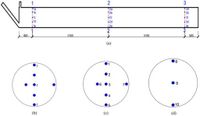In the field of civil engineering, the bonding properties between steel and concrete play a crucial role in ensuring the stability and longevity of structures. Recent research conducted by a team led by Deng Y., Zhang H., and Ni J. has shed light on this matter by investigating how internally welded steel bars can enhance the bonding between steel pipes and concrete within concrete-filled steel tube (CFST) structures. Their findings suggest effective methods to prevent debonding and improve structural performance.
Concrete-filled steel tubes have gained popularity due to their unique ability to combine the advantages of high-strength steel with high-performance concrete, resulting in composite structures that are not only strong but also durable against environmental factors. However, challenges persist concerning the debonding of the concrete from the steel pipe, leading to various structural issues over time. Understanding and improving the bond strength between these two materials is vital for the safety and longevity of CFST designs, particularly in dynamic situations such as bridges and tall buildings.
In their study, the researchers utilized Q420qD steel pipes and C60 self-compacting concrete, focusing on the internal welding of steel bars as a reinforcement strategy. Through a series of elaborate push-out tests and ultrasonic examinations, they found that the internal welding significantly enhances the bond strength at the interface of the steel pipe and concrete. The experimental setups revealed that as the number of internally welded steel rings increased, the push-out length—the distance the concrete could slide away from the steel pipe—decreased, indicating a stronger bond.
One of the most compelling outcomes of this research was the ability of the welded reinforcements to reduce void defects within the concrete. The tests demonstrated that when three rings of internal steel bars were employed, along with a spacing of 350 mm between the rings, not only was the bond strength optimized, but the structural integrity was also bolstered against vibrations and external loading. As stated in the study, "The results demonstrate that the best effect is achieved when the number of circular steel bars is welded for three turns and the spacing is 350 mm," wrote the authors of the article.
To substantiate their findings, the researchers conducted finite element simulations which complemented the experimental data. This dual method of validation provided a robust framework for understanding the bond-slip characteristics of the structures being tested. Ultrasonic tests were particularly instrumental in showing how the bond quality evolved over time, with progressive improvements noted on Days 2, 5, and 7 after installation. Even as initial voids were identified, the concrete's adhesion to the steel improved significantly as it cured.
Concrete complexity did not end with just strength; the study also highlighted the temperature influences and environmental interactions that typically cause degradation in traditional structures. It emphasized that the internal welded bars could significantly reduce moisture infiltration and protect against deterioration from temperature fluctuations or chemical exposure. As noted in the research, "Internally welded steel reinforcements significantly improve the bonding performance of CFST structures," wrote the authors of the article, underlining the practicality of this approach in the field.
The implications of these findings suggest a forward momentum in engineering practices, especially relevant to the increasing demand for resilient infrastructure capable of withstanding earthquakes and heavy loads. The introduction of welded reinforcement strategies is positioned to enhance the design and safety of CFST structures further.
In conclusion, this groundbreaking work not only provides an empirical basis for improving structural design through enhanced bonding strategies but also serves as a valuable reference for future engineering applications. By refining the bonding interface between steel and concrete using internally welded steel bars, engineers can mitigate the risk of debonding, thus extending the service life of critical infrastructure.

